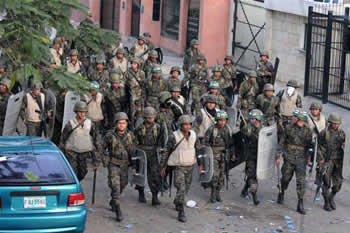by Deep Green Resistance News Service | Sep 12, 2013 | Indigenous Autonomy
By Jeremy Hance / Mongabay
One-hundred and fifty years after a treaty with England granted the Miskito people rights over their land–a treaty which was never fully respected–the government of Honduras has officially handed over nearly a million hectares (970,000 hectares) of tropical forest along the Caribbean Coast to the indigenous people. The Miskito are found along the eastern coast of both Honduras and Nicaragua and number around 200,000.
“This is an unprecedented and historic moment for our peoples,” said Norvin Goff, chairman of Miskitu Asla Takanka (MASTA), a Honduras group representing the tribes.”The entire region is at risk from illegal hunting, logging and clearing of land to graze cattle. The Miskito people can protect it, but only if we have title to those lands.”
Over the last few decades, tropical forests along the Caribbean Coast have been infiltrated by land speculators, loggers, and ranchers, creating conflict between the illegal settlers and the Miskito. The Miskito now have title to seven land areas, comprising 128 communities, and about seven percent of Honduras’ total land area.
The official rights to their land will allow the Miskito to negotiate possible REDD+ treaties in the future. REDD, which stands for Reducing Emissions From Deforestation and Degradation, is a UN program that aims to cut global carbon emissions by paying tropical countries to keep their forests standing.
“We have been doing REDD for 500 years,” notes Goff. “Now we will be able to teach others how we have protected our forests and natural resources, and benefit from our role in helping the world that wants so badly to stop destroying the forests so we can slow climate change.”
Around 40 percent of Honduras is covered in forest, but the country has one of the highest rates of deforestation in Latin America. From 1990 to 2005, Honduras lost 37.1 percent of its forestland. The country is still home to a number of important Neotropical species such as the jaguar (Panthera onca), Baird’s tapir (Tapirus bairdii), giant anteater (Myrmecophaga tridactyla), and mantled howler monkey (Alouatta palliata).
“With a substantial proportion of the total territory of Honduras now owned by Indigenous peoples, we envision the creation of a new development agenda in Honduras, one built with guidance from indigenous peoples and with respect for our customary rights,” Goff said.
From Mongabay: “Indigenous people of Honduras granted one million hectares of rainforest“

by Deep Green Resistance News Service | Jun 1, 2012 | Colonialism & Conquest, Indigenous Autonomy
By Rights Action
On May 22 and 23 a delegation of human rights activists from the United States organized by Rights Action and Alliance for Global Justice visited the community of Ahuás in the Moskitia region of Honduras. The delegation witnessed an atmosphere of terror being generated amongst dire poverty in an area where the indigenous people are now losing control of natural resources which are key to the development of their economy.
The group inquired into the May 11, 2012 massacre of indigenous Miskito people by gunfire from U.S. State Department – titled helicopters that the US government confirms carried U.S. DEA agents and security contractors. The boat and its passengers had almost completed an eight hour trip to Ahuas from the town of Barra Patuca. Four were killed, including two pregnant women, a 14-year-old boy and a 21-year-old man, while at least four more were seriously injured.
Following the massacre at least one helicopter landed and at least ten, tall, light-skinned English speakers with limited Spanish proficiency wearing military type uniforms exited the helicopters to collect cocaine from a boat near the massacre site. They aimed guns at, threatened to kill, and handcuffed residents of the town who had come to assist the wounded. Victims lay on the banks of the river and in the damaged boat until after helicopters departed. In this way security forces delayed emergency medical assistance two to three hours.
Neither U.S. nor Honduran authorities have interviewed the eye witnesses or secured evidence at the crime scene, indicating that no serious investigation has been conducted into the massacre. Even without conducting a serious investigation U.S. and Honduran officials have accused the victims, the population in general and local authorities of participating in drug trafficking.
Since the massacre Ahuas has been occupied by several dozen Honduran troops, and it is reported that U.S. military presence in the vicinity of Ahuas is increasing. U.S. government authorities recognize that counterinsurgency tactics are being used while they identify the indigenous communities as drug traffickers. Indigenous communities in Central America have once again become the focus of U.S. counterinsurgency actions.
Many people the group spoke with noted that militarization and violence generated by the U.S. drug war is focused where there are significant natural resources, Ahuas is known to hold significant petroleum deposits and Texas-based Honduras Tejas Oil and Gas Company, a joint venture with concessions in the Moskitia, estimates there are six to eight billion barrels of oil reserves in the Moskitia.
The delegation is calling for a serious and credible investigation including a Congressional hearing that identifies criminal responsibility in the massacre, the withdrawal of U.S. security forces from Honduras, and suspension of U.S. military assistance to Central America.
From Rights Action:

